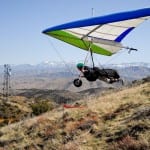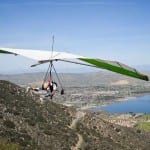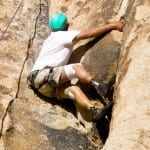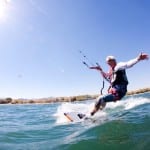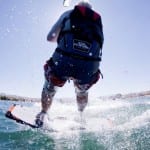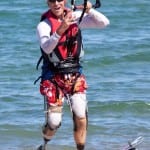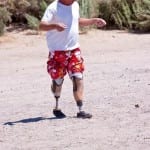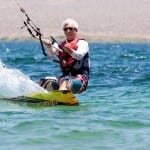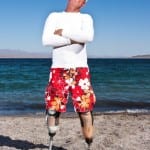By Paul Lang
Billy Floyd is a kiteboarder, just like the rest of us. He centers his schedule around when the wind is expected to blow, has a van full of kite gear, and likes to tinker with his equipment. He’s built a few of his own boards and loves to talk about how much fun he had during his last session. Billy started kiteboarding about four years ago and is working on getting his back rolls dialed in and has landed a few front rolls. Basically, he sounds like an average kiteboarder, but there is something that makes Billy stand out from the regular crowd of kiters.
{openx:86112}
What makes Billy Floyd different from the rest of us is the extra step that he has to do before every session. After he finishes pumping up his kite, Billy has to sit down in his van and strap on two carbon fiber and aluminum prosthetic legs before he can get out on the water.
I first met Billy Floyd through email. He would occasionally send me photos and entertaining descriptions of his last kiteboarding session. “We’ve had mostly storm fronts now with erratic winds. I did get lucky a week ago with really nice 20-22 all day. I landed my first front roll but when I went to power up the kite to ride away, it wasn’t where I envisioned it, and this really sick feeling hit my gut a moment before I got launched!”

Shortly before I traveled out to Lake Mohave on the Nevada/Arizona border to meet him in person, I got a message from him that his leg had come off during a back roll, sank, and was now resting at the bottom of the lake. “I’m the legless white-haired guy that used to be able to walk until yesterday! Mohave blew 18-25 all day and I was having the best day of my life ever until I crashed and lost my right leg to the bottom of the lake. The back roll was finished and all by buddies are standing on the beach yelling so I decided to show off and toss a kite loop just as the board was about to touch down. Then I got launched! It was an expensive day, but the best day of kiting I’ve ever had, all four hours of it.” Fortunately, Billy had a friend with some scuba gear who went out to Mohave to look for his leg. A few days later, I got another email from Billy that contained a photo of four guys proudly holding his missing leg on the beach like it was a prize-winning fish.

Formerly in Army Intelligence, Billy Floyd moved to San Diego to attend Mesa College in 1976 once he got out of the Army. A chance visit to the seaside hang gliding port of Torrey Pines turned out to be a life-changing experience. “So I go out to Torrey Pines, and I see this guy doing wingovers, like he’s just bouncing off a cushion of air. Oh my God, you can do that? I was hooked right there! I’ve got to do that!” Before long, Billy was giving tandem hang gliding rides over the beach at $20 a pop to pay the bills. “I could do four to five an hour, so for three hours of tandem rides I could bring home a pretty good day’s pay.”
In 1985, he had his first accident. “You are talking to a guy who died. I was up about 450’ above Torrey Pines, not doing any aerobatics, just minding my own business, and a side wire breaks. It turned out the wire was twisted and running over a sharp edge. When I was checking the glider before I took off, the guy who owned it said, ”˜Hey I just landed the thing, it’s fine,’ so I didn’t do my pre-check. Then, the girl that usually packs my parachute walked by and said, ”˜Now Billy, I haven’t packed your chute in a year, it’s time.’ I pulled off my parachute and handed it to her, so now I don’t have a parachute and I’m on a glider that’s going to break in 15 minutes. When the side wire snapped, the wings folded in half and I plummeted. I remember hitting the ground and I stood up; I just had so much adrenaline going. I went, ”˜Oh, this isn’t good,’ and I lay back down and then I remember kind of like phasing right out of my own body. Luckily, I was CPR’d back so I didn’t have to meet the maker. It wasn’t fun at all.”

After he recovered, Billy kept on hang gliding and giving rides at Torrey Pines until the FAA changed the rules about tandem rides. “The FAA came in and said no more tandem rides. They had to be lessons, and I didn’t want to give lessons, because then you have to be an instructor.” This change in rules led to a series of hang gliding trips to Canada with his good friend Scott Kurth. “I went up to British Colombia and started barnstorming around all of these really cool mountains up there. For five straight years in a row, I would make enough money in two months to pay rent for the entire year.” Scott first met Billy at Torrey Pines and was immediately blown away by the type of flying he did. “He showed up one day and turned my whole view of flying hang gliders upside down. What he did is what I would call freestyle flying. He was doing these amazing sliding landings, wing-tip dragging turns, and other moves I didn’t realize were possible,” said Scott. “I latched onto him immediately and he turned out be an outstanding tutor and buddy. It wasn’t long before we were both doing sliders, touch-and-go’s all over the cliff, and swooping down onto the golf course to pluck golf balls off the fairway and drop them on the green. Bill also educated me in the art of selling rides. We would find a pullout on a mountain road that was launchable and set up the tandem gliders. When curious onlookers stopped he would go into the sales pitch and base the price on the car they drove or clothes they wore. We supported ourselves on more than a few trips to Canada by selling rides that way.”
A little more than four years ago, Billy learned to kiteboard while continuing his hang gliding, and was ranked fourth in the world in hang gliding acrobatics. About two and a half years ago, Billy had his second hang gliding accident. “Overconfidence got me. I was towing up in a hang glider, and I had no concept of the rules of towing. I just had this totally immortal attitude that I couldn’t die. I forgot to hook into the glider. Had the tow bridle been an under bridle, I could have let go and would have just been dragged by the tow truck for a bit. Because it was an over-under bridle, the over part kept me stuck to the glider, and I was going up no matter what. Then I went for my parachute, because this time I had one. So I’m hanging on underneath the glider, and I let go with one hand and grab my parachute handle. The problem was that the bridle that hooked me to the tow line went right over the parachute handle, so I couldn’t grab it. Now the glider is starting to lock out, and I knew that if that happened I was dead for sure. So I reached up and popped the release on the tow line and I just couldn’t hang on. There was so much energy built up that the glider shot up as soon as I released. The bar got ripped right out of my hands and I fell right into the ground, feet first. On the ground, I turned around behind me and saw this mess of blood and bones. I looked down at my legs and everything below the knees was just exploded. The first thought that went through my head was, ”˜Now I know what the gazelle feel s like when he’s being eaten by a lion.’ You know what he feels? Nothing. It was better than the morphine they gave me at the hospital. In my first accident I let go and drifted away from my body and they had to CPR me back, but this time I was like, ”˜There’s no way I’m letting go. I’m staying right here.’ When the helicopter showed up and shot me full of morphine, that’s when I let go. Twelve thousand dollars for a helicopter ride and I don’t even remember being loaded in it.”

In the hospital, even before his legs were amputated, Billy already knew that he would be back on the water and back in the air. “They were setting me up for the surgery, and I was already thinking about how I could get back onto the board. I had put drywall up before using stilts, and I just thought walking around on prosthetics can’t be much different than that. Another thing that helped me a lot is that when I was in high school, the place kicker on the football team had no legs, and man could he kick that ball. I just had an idea that if I set my mind to it, it could be done.” His friends who visited him in the hospital were amazed at how upbeat he was given the circumstances. “When I visited him in the hospital two days after his accident he was upbeat, joking, and already planning new adventures, pondering how he would be able to kite and hang glide again. He was totally upbeat and optimistic. I would have been devastated,” said Mark Barry, a Lake Mohave kiter.

Even though he knew he would be kiting again, Billy gave his kiteboarding gear away to Scott Kurth so that he and his son could learn to kiteboard together on the equipment he wouldn’t be able to use for awhile. “Towards the end of my first conversation with Billy after the accident, he started going off about this kiteboarding thing and how much fun he was having with it,” said Scott. “I mentioned that I had been eyeing it but did not want to abandon my family for a new wind activity as I have trouble with self control when hooked by a new sport. He offered his kite gear to me and explained that kiting was something I could do with my eight-year-old son. It didn’t take any more convincing. Billy sealed the deal by sending me his 13m and I picked up a 6m for my son. A few months later we were on the water together.” After the accident, Billy spent a year in a wheelchair, and was so determined that he would be kiteboarding again that he bought another set of kiteboarding gear before he had his first prosthetic legs. “I knew for sure that I would be kiteboarding again. I didn’t have a single doubt in my mind, so I bought a kite. Some people were telling me I should get one of those Peter Lynn catamaran things and do it in that, but I thought no, I’m going to kiteboard. I just need to learn the new tricks.”
Three weeks after getting his prosthetic legs, Scott invited Billy to join his family in Joshua Tree for the weekend. “I hadn’t really figured out how to use my legs yet, and since I had spent a year in a wheelchair, my knees were kind of weak.” Billy watched Scott’s six-year-old daughter tie into a rope and climb an 80’ vertical rock wall. When she got back down, she walked over to Billy and said, “Well Uncle Billy, I think it’s your turn.” Billy had never gone rock climbing before and was still using crutches with his new prosthetic legs. “I guess it was my Italian ego. I can’t get challenged by a six-year-old girl and not at least accept. Scott said, ”˜Maybe you can just go ten feet. You’ll be doing something if you go ten feet.’ So, they put climbing shoes on my prosthetics, and I went up ten feet. Then I did ten more, then another ten, all the way up to the top.”

To get back into kiteboarding, Billy first started off by doing body drags again. “Ramona Nelson, another Lake Mohave kiter, helped me out a lot. She would launch the kite for me, and then bring it over and transfer it to my harness. Then I would do body drags back and forth at Boulder Beach. I did that for awhile. Then one day she grabbed my board, chucked it out to me, and said, ”˜Billy, I’m pretty sure you can do this.’” Once Billy figured out the technical challenges of riding on prosthetics, he was up and going. “If I stand duck-footed, which is how most people ride, my feet don’t stay flat when I bend my knees. I actually have a pigeon toe stance to keep my feet flat on the board, which is a little awkward, but it works. It’s a good thing that I learned to ride before I lost my legs, because I think it would have been too hard to learn with no legs. Now that I’ve done it and I’ve figured it out, I could take someone who has prosthetic legs and teach them how to kiteboard.”
Most kiteboarders take for granted how much feedback they get from feeling the board under their feet. Billy doesn’t take that for granted, because he can’t feel what the board is doing. “With me it’s not by feel at all. As much as you look in your rearview mirror to see what the traffic is doing around you, that’s how much I have to look at the wake coming off my fins. Then I have to check the angle of the board to make sure the nose isn’t up too high. Then I’ll back off a bit and bring the board slightly more upright and then edge back to where I was, paying attention to whether I pick up speed or loose speed. I have absolutely no feeling whatsoever below my knees, so I have to visually look at the board to see what is going on.”
Billy is part of a small group of Las Vegas kiteboarders that ride at Lake Mohave, which is located in the middle of the desert about an hour from Las Vegas. Another member of the local kite crew, Craig Lumpp, met Billy when the two went land sailing together. “Last fall, I suffered a fairly significant knee injury from kiteboarding and was sidelined from the water for a couple months. A mutual kiter friend let Bill know that I was out of commission, and after some email correspondence we made plans to do some land sailing. Bill reminded me to make sure to ”˜Remember to bring cold beer.’ This was the first time I had hung out with Bill. Here was this boisterous, completely wired, seemingly crazy 56-year-old legless guy who loves wind, flying, and adrenaline. It was really quite a funny thought – two adrenaline junkies, one with no legs, another with a busted knee who where out to get their wind fix by land sailing. Needless to say, we’ve been friends ever since and spend plenty of time chasing wind, catching epic sessions, and drinking some cold beer.”
Earlier this year, Billy decided to get back on the horse that threw him off and get back into the air on a hang glider. His attitude towards jumping off the side of a mountain again should be an inspiration to the rest of us when we have to tackle something in our lives that makes us nervous. “I was standing with one of the best pilots in the world right next to me. I turned around and said, ”˜I used to do loops on a hang glider. I was a world-class acrobatic pilot. Now, I’m going to do a sled ride on a beginner glider.’ Then I rolled my hands over and showed him the sweat dripping off my palms. He said, ”˜Bill, you have every right to be a little nervous, but you’re Billy Floyd. Once you get in the air, everything will be fine.’ As soon as I got in the air, everything was like I was flying just yesterday. It’s weird, you can get these feelings of anticipation, but once you’ve actually made the leap, it’s too late now. You need to deal with your environment, not your emotions. I had made that decision before I jumped. OK, I am nervous, but as soon as I am in the air and I have to do this, I will. In the air, it was like someone flipped a switch, and I felt like I had been flying my whole life.”



